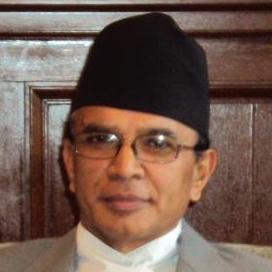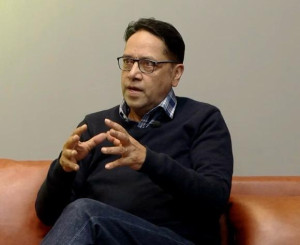Books
A civil servant's treatise on corruption
Sharad Chandra Paudel’s latest book, Bhrastachar—Kaaran, Parinam ra Niyantranka Upaya, offers readers a comprehensive take on corruption in the country.
Madan Kumar Bhattarai
Sharad Chandra Paudel, a bureaucrat with three and a half decades of experience and who retired as Secretary to the government, has authored a new book entitled 'Bhrastachar—Kaaran, Parinam ra Niyantranka Upaya', which can roughly be translated to 'Corruption—Causes, Consequences and Ways of Control'.
Possibly the first of its kind in Nepal, the impressively voluminous work with comprehensive focus on corruption is a must-read by the general public and civil servants, political leaders, lawyers, civil society representatives, students and all those interested in the subject.
Originally from Tanahun district, the writer is a second-generation civil servant. Paudel's father retired as a class II officer of the Government of Nepal officer. Paudel joined the Ministry of Health as his maiden administrative posting and rose through the ranks and successively handled various responsibilities involving ministries of general administration, local development, home and forest, apart from his stint in the National Planning Commission.
While corruption is a hotly debated subject both nationally and internationally, there is a paucity of a comprehensive book on the subject and Paudel has done a great service by bringing out such a thorough work on the subject. The book has twelve chapters with two appendices. In the preface, the writer focuses on the malaise of corruption in Nepal and states that the narrow intellectual base of the country has resulted in a situation of apathy or ignorance on the part of the enlightened or privileged group of people who actually run the show.
The first chapter deals with the introductory part, covering definition, elements and types of corruption from a historical perspective. It also dwells on all relevant national and international instruments including the establishment of the Transparency International constituted in 1993, suitably corrective measures undertaken by other major institutions subsequently like the World Bank (1997), the United Nations (1997) and the Asian Development Bank (1998). The second chapter focuses on causes of corruption in public and private sectors. It talks of a powerful nexus between politicians and civil servants, either through direct participation or passive resistance, that has helped foster corruption in the public delivery system and other areas. The writer also feels that foreign aid and political transition have become breeding grounds for corruption and other malpractices.
The third chapter covers various forms and modalities of corruption involving all stakeholders, corrupt, corrupter and mediator or interlocutor. The fourth chapter is related to the serious impact of corruption from economic, political, administrative, social and environmental perspectives. Chapters five and six deal with theories of corruption and prevalence of endemic corruption in diverse sectors of national life respectively.
Similarly, chapters seven and eight respectively attempt to scrutinise bases of corruption and ways and means of controlling corruption in the political sphere that has largely proved elusive. Chapter nine is very relevant in the sense that it pertains to evaluation of efficacy and pitfalls in the task of controlling corruption in the administrative sector. Likewise, chapter ten deals with the tricky issue of controlling corruption in the judicial field from various angles.
Chapter eleven covers other modes of corruption control including the role of international community and the utilisation of international resources. It also deals with corruption from the prisms of politics and economics, and the role of the private sector, civil society and media in exposing and combating corruption. The last chapter presents specialised institutions and instruments for controlling corruption and seeks to examine preventive, curative and behavioural measures in tackling corruption with focus on resource management, civil servants and development.
At the end of the book, the author has thought it pertinent to include two tables in the form of appendices depicting expenditures on the part of thirteen countries in terms of highest military spending and transactions of the world's top fifteen business houses. The obvious intention of the author is to highlight the prevailing nexus and intricately close association between public and private sectors in terms of accentuating the evils of corruption defying public opinion at home and abroad.
And Paudel too has been shrouded in a case of corruption. He was implicated in a case filed by the Commission for Investigation of Abuse of Authority CIAA), an agency that is itself under cloud for many years, and he spent more than three years in virtual isolation and trauma fighting litigation before he was acquitted of all charges.
Besides serving as a standard textbook on corruption, the book is, therefore, not only a victim's perspective and intends to serve as a wake up call to each and every Nepali: that unless they join hands to address the core issue of corruption, our aspirations for social and economic transformation will at best remain a pipe dream.
Two other positive aspects of the book also need emphasis. While calling corruption a deflection of the accepted order of any society, the author paints a constructive note saying that if sincere efforts are to be made, corruption can be controlled or minimised. Second, unlike many other books by civil servants or political people that have virtually flooded the market now, it refrains from what can be called a symptom of self-admiration.
Paudel has been able to present a coherent picture of both theoretical and practical aspects of corruption in simple and readable language. The book, however, suffers from some weaknesses. First, there are mistakes galore in the form of proofs. The second aspect is that though the book covers a wide spectrum of issues and incidents relating to corruption in the world at large, it displays obvious reluctance from the author’s part to deal with major cases of corruption in the country despite some sketchy treatment of the matter here and there.
———————————————————————————————
Bhrastachar—Kaaran, Parinam ra Niyantranka Upaya
Sharad Chandra Paudel
Publishers: Sangri-La Books
Pages 766
Price: Rs 1,195




 8.12°C Kathmandu
8.12°C Kathmandu











